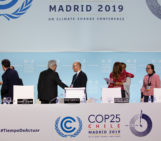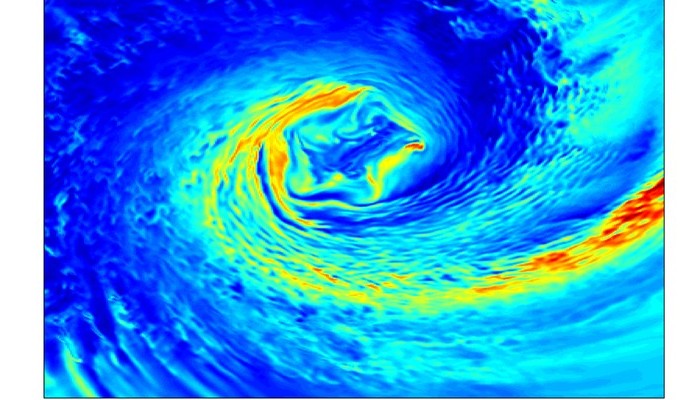
The air we breathe is full of tiny particles that can have a big impact on our climate. Industrial activities have greatly increased the number of these particles, cooling the climate and potentially offsetting some of the warming due to greenhouse gases. In this post Kirsty Pringle introduces new research that suggests that it might not be possible to quantify the effect of industrial emissions on climate unless we constrain estimates of the natural emissions (Carslaw et al 2013). Kirsty is a member of Ken Carslaw’s research group at the University Of Leeds (UK) which performed the research.
Deserts, oceans, fire and even pine forests emit tiny particles called aerosol into the atmosphere. Human (anthropogenic) activities also play a role; burning fuel, e.g. in cars or power-plants, emits particles and aerosol concentrations have increased substantially since the start of the industrial revolution. One effect of these particles is to change the properties of clouds, causing them to become brighter, producing a net cooling that can offset some of the warming due to greenhouse gases. Treating this effect in climate models is challenging and it remains one of the most poorly quantified areas of climate science.
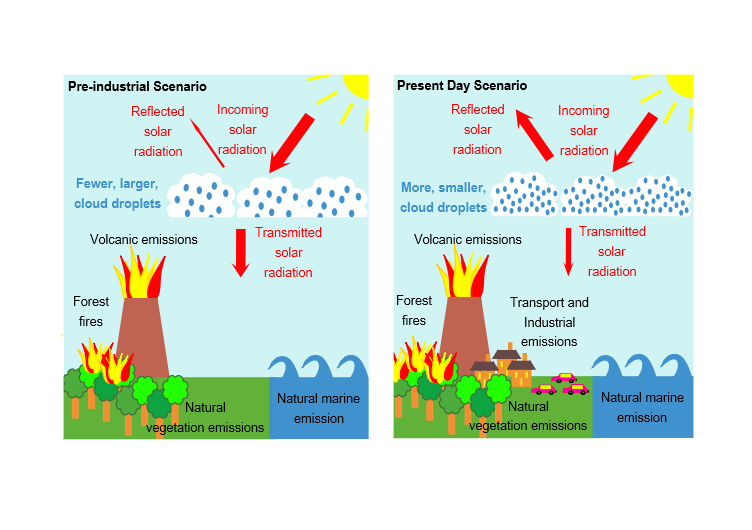
Schematic of the first aerosol indirect forcing: Human (anthropogenic) emissions add aerosol particles to the atmosphere, these particles can act as condensation sites, which aids cloud droplet formation. Anthropogenic emissions result in clouds with more, smaller, cloud droplets. These clouds are brighter and reflect more solar radiation, resulting in a net cooling. The first aerosol indirect forcing (AIE) is the change in the reflected solar radiation between the present day and the pre-industrial scenarios due to this effect. Click image for a larger version. (Credit: Kirsty Pringle)
This cloud brightening effect is called the first aerosol indirect effect (AIE). It is thought to produce a global average cooling that is sufficient to offset between 25 to 90% of the warming due to long lived greenhouse gases (IPCC). The AIE is challenging to treat in climate models as atmospheric aerosol has a range of sources, the magnitudes of which are quite uncertain. They also undergo a series of processing steps in the atmosphere, which can change their properties; affecting both their lifetime and their ability to interact with clouds. These processing steps are difficult to represent in climate models and this complexity contributes to the large range of estimates.
As the aerosol indirect effect (AIE) is potentially large, but very uncertain, it is important to try to understand where this uncertainty arises. This has been a focus of Ken Carslaw’s research group for the past four years where a new collaboration between aerosol scientists and a statistician has resulted in some very long meetings, a new approach to uncertainty analysis, and the first study that has identified and quantified the factors that contribute to uncertainty in model estimates of the AIE.
I should clarify that Carslaw just considered parametric uncertainty, this is the uncertainty associated with inputs to the model, e.g. the magnitude of the emissions or uncertain values used within parameterisations. There are other types of model uncertainty, e.g. structural uncertainty, that were not considered in this study. Parametric uncertainty is, however, intrinsic to all climate models, so it is an important starting point.
The first step was to choose which parameters to focus on. The team did this by talking with other scientists to identify which input parameters everyone felt were most uncertain; together they estimated the maximum, minimum and median value for each parameter. They identified 28 uncertain parameters in total; these can be grouped into three categories:
- Natural emissions (e.g. volcanic emissions, marine sea spray emissions), 6 parameters.
- Anthropogenic (human-caused) emissions (e.g. fossil fuels emissions, biofuel emissions), 8 parameters.
- Process parameters used within the aerosol microphysics (e.g. the rate of aerosol aging, or the wet deposition parameter), 14 parameters.
The contribution of each parameter to the uncertainty in the AIE calculation can be found using a statistical technique called Monte Carlo analysis, but to perform Monte Carlo sampling on 28 uncertain parameters one would need to run tens of hundreds of model simulations, which isn’t possible with a complex model. To avoid this, Carslaw ran a few hundred simulations and used a statistical emulator to carry out the Monte Carlo sampling much faster. The emulator is a statistical package that “learns” from the output of the computer model, it can be used to interpolate from the hundreds of runs performed to the thousands of runs needed for the statistical analysis.
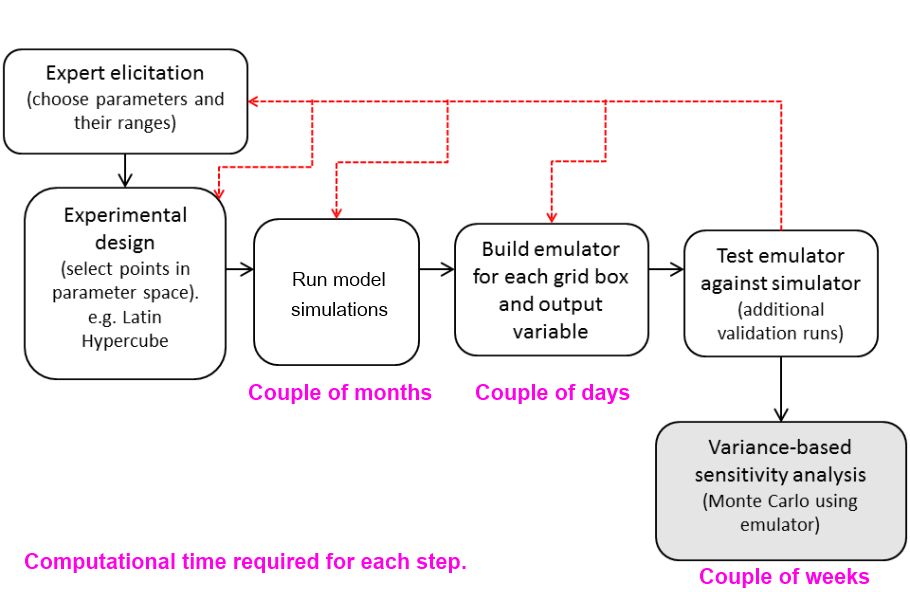
Schematic showing the methodology used by Carslaw to perform a sensitivity analysis on the first aerosol indirect effect (AIE). (Figure courtesy of Lindsay Lee).
Carslaw found that by varying the values of the uncertain parameters, the model produced a range of estimates of the strength of the AIE forcing that was similar to, but slightly smaller than, the range of values estimated by the multi-model estimate from the IPCC. Surprisingly 45% of the uncertainty was found to be due to uncertainty in natural emissions, 34% was due to uncertainty in anthropogenic emissions and the rest due to uncertainty in process parameters.
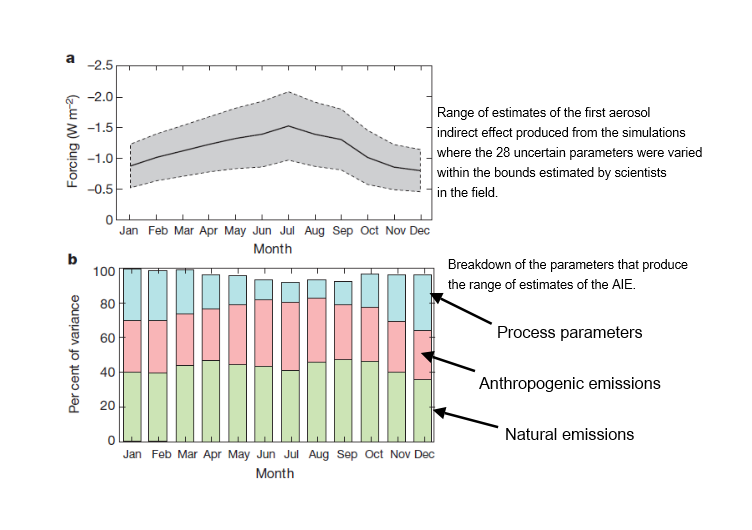
Caption: Magnitude and sources of uncertainty in the model estimate of the first aerosol indirect forcing. (Credit: Carslaw et al, 2013)
Although the forcing is caused by anthropogenic emissions, the amount of natural emissions has a large effect on how sensitive the climate is to these anthropogenic emissions: the natural emissions don’t produce the forcing but they contribute a lot to the uncertainty in the forcing.
This effect arises because the relationship between aerosol emissions and cloud brightness is not linear; instead it is curved with higher sensitivity of cloud brightness to emissions when emissions are low (as they were in the pre-industrial atmosphere). This means that in the clean pre-industrial atmosphere a change in the amount of natural aerosol emissions has a large effect on the cloud brightness: when natural emissions are small, the initial cloud brightness (albedo) is low and any anthropogenic emissions have a big impact on cloud brightness, so the calculated forcing is larger.
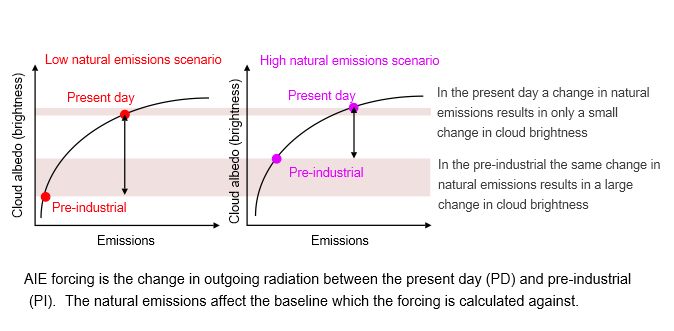
Schematic explaining why the calculation of the first aerosol indirect forcing is sensitive to the magnitude of the natural aerosol emissions. (Credit: Kirsty Pringle).
This sensitivity to the natural aerosol emissions is important as it is very difficult to constrain estimates of natural aerosol emissions as measurements taken in today’s atmosphere are almost always affected by anthropogenic emissions. This means that some of the uncertainty in the estimates of the first aerosol indirect effect may be irreducible, but it will still need to be considered in future estimates of warming due to greenhouse gases.
By Kirsty Pringle, Research Fellow, School of Earth and Environment, University of Leeds
References
Carslaw, K.S., et al.: Large contribution of natural aerosolos to uncertainty in indirect forcing, Nature, 503, 67-71, 2013
Lee, L. A., et al.: The magnitude and causes of uncertainty in global model simulations of cloud condensation nuclei, Atmos. Chem. Phys., 13, 8879-8914, 2013
Lee, L. A., et al.: Emulation of a complex global aerosol model to quantify sensitivity to uncertain parameters, Atmos. Chem. Phys., 11, 12253-12273, 2011
GeoLog regularly brings readers information about recent research in the geosciences as well as updates on the EGU’s activities. Part of what makes GeoLog a great read is the variety that guest posts add to our regular features, and we welcome contributions from scientists, students and professionals in the Earth, planetary and space sciences. If you want to report on a recent Earth science event, conferences or fieldwork, comment on the latest geoscientific developments or highlight recently published findings in peer-reviewed journals, like Kirsty has done here, then we welcome your contribution. If you’ve got a great idea, why not submit a post?



